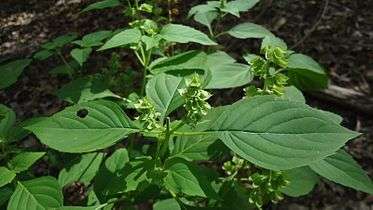Ocimum campechianum
| Ocimum campechianum | |
|---|---|
 | |
| Scientific classification | |
| Kingdom: | Plantae |
| (unranked): | Angiosperms |
| (unranked): | Eudicots |
| (unranked): | Asterids |
| Order: | Lamiales |
| Family: | Lamiaceae |
| Genus: | Ocimum |
| Species: | O. campechianum |
| Binomial name | |
| Ocimum campechianum Mill. | |
| Synonyms [1] | |
|
Ocimum micranthum Willd. | |
Ocimum campechianum is a plant species in the Lamiaceae, widespread across Mexico, Central America, South America, the West Indies, and Florida.[2]
Leaves of Ocimum campechianum are eaten in Brazil's Amazon jungle. Similar to basil, it has a pungent flavor and contains essential oils which have been used ethnomedicinally. In Amazonia, the aromatic leaves are used as an admixture in ayahuasca brews. The plant is called xkakaltun in Mexico's Yucatan Peninsula, where it is considered a honey plant and is used as an abortifacient.[3] It is referred to in Brazil as alfavaca and has also been referred to as albahaca del monte,[4] Amazonian basil, wild sweet basil, wild mosquito plant, least basil, Peruvian basil, spice basil, alfavaca-do-campo, manjericao and estoraque.[5][6]
Essential oil
Essential oil from O. campechianum has been tested for its in vitro food-related biological activities and found comparable to the essential oils of common basil and thyme and superior in its capacity as an antioxidant. It has also been found to possess antifungal activity against food spoiling yeasts. The leaves have the highest concentration of essential oil (4.3%).[7][8]
References
- ↑ "Ocimum campechianum Mill.". Germplasm Resources Information Network. United States Department of Agriculture Agricultural Research Service. Retrieved September 26, 2012.
- ↑ Kew World Checklist of Selected Plant Families
- ↑ Rätsch, Christian (2005). The Encyclopedia of Psychoactive Plants: Ethnopharmacology and its Applications. One Park Street, Rochester, Vermont 05767: Park Street Press. p. 573. ISBN 978-089281978-2.
- ↑ "Albahaca". Plantas Que Curan (in Spanish). Retrieved 17 June 2014.
- ↑
- ↑ http://www.drugs.com/npp/amazonian-basil.html
- ↑ http://onlinelibrary.wiley.com/doi/10.1002/ffj.1374/abstract
- ↑ Sacchetti, G.; Medici A; Maietti S; Radice M; Muzzoli M; Manfredini S; Braccioli E; Bruni R. (2004-06-02). "Composition and functional properties of the essential oil of amazonian basil, Ocimum micranthum Willd., Labiatae in comparison with commercial essential oils.". J Agric Food Chem. 52. 52 (11): 3486–91. PMID 15161220. doi:10.1021/jf035145e.